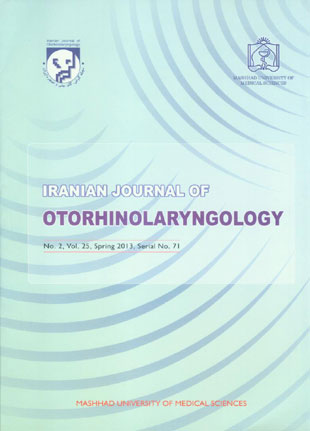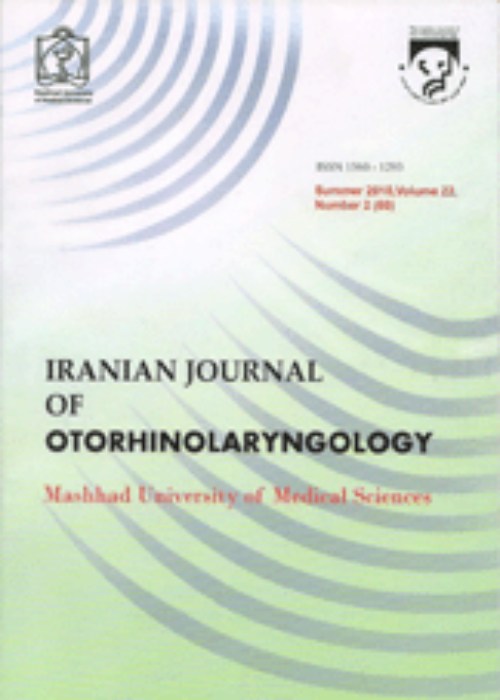فهرست مطالب

Iranian Journal of Otorhinolaryngology
Volume:25 Issue: 2, Spring 2013
- تاریخ انتشار: 1392/01/27
- تعداد عناوین: 10
-
-
Pages 63-70IntroductionTo reduce incidence of residual cholesteatoma following ear surgery; and to reduce the need for second look “open” mastoidectomy using endoscopic mastoidotomy. Ten-year retrospective chart review of 249 primary cholesteatoma cases (1994-2004) with a minimum follow-up of two years. The first objective was to evaluate the effectiveness of otoendoscopy in reducing the incidence of “cholesteatoma remnant” at the time of primary surgery. The second investigation was to evaluate the effectiveness of otoendoscopy in reducing the need to open the mastoid cavities during “second look operations”.Materials And MethodsEndoscopes were used on all cases as an adjunct to standard microscopic methods. Once all visible cholesteatoma was removed with standard microscopic techniques, endoscopes were utilized in order to identify any “remnants” of cholesteatoma. Endoscopes were also employed during revision second look cases in order to allow the evaluation of intact canal wall mastoid cavities without an open Mastoidectomy approach.ResultsEndoscopy at time of primary operations revealed a 22% incidence of hidden cholesteatoma “remnants” despite apparent total microscopic eradication in closed cavity cases, and 10% in open cavity patients. Endoscopic removal of cholesteatoma remnants reduced the long term cholesteatoma “residual” to 9.7% in closed cavity patients. Furthermore, endoscopic surgery significantly reduced the need to open the mastoids during second look operations.ConclusionOtoendoscopy is a very effective adjunctive method in ear surgery. It allows significant reduction in cholesteatoma residual rate in both closed cavity and open cavity cases. Furthermore, the great majority of second look mastoids can be evaluated endoscopically and thus avoid an open revision Mastoidectomy.Keywords: Cholesteatoma, Ear surgery, Endoscopic
-
Pages 71-78IntroductionSeptal deviation is the chief cause of chronic nasal obstruction. In order to treat such cases, nasal septoplasty surgery is usually performed based on patient complaints and a surgeon''s examination, both of which are subjective. This study aims at using the objective parameters of acoustic rhinometry and rhinomanometry to evaluate the effectiveness of septoplasty surgery.Materials And MethodsA prospective study was performed in 30 candidate patients for septoplasty surgery. Acoustic rhinometry and rhinomanometry tests were performed on all patients both before and 3 months after the operation. The symptom recovery rate was recorded according to the patient''s statements and anterior rhinoscopic examinations 3 months after surgery. Data were analyzed using a t-test and chi-square tests in a SPSS package.ResultsA total of 26 of 30 patients returned for a post–procedure follow-up examination after 3 months. Patients were aged from 18 to 32 years (average, 25 years). In total 69.2% (18 patients) were satisfied with the results of the procedure. In addition, rhinomanometry resulted in a decrease in general nasal resistance if patients used decongestants (P=0.03). However, the decrease was not significant before the use of decongestants (P=0.12). Furthermore, according to the results from acoustic rhinomanometry, there was an increase in the nasal cross-sectional area on both the narrow and wide sides after the operation (P<0.05), although this increase was not so notable in the narrower side after using decongestants. There was, however, no significant relationship between the results from the objective tests and the patient''s symptoms or clinical examinations (P>0.05).ConclusionThe findings of this study show that although the objective tests confirm an improvement in general nasal resistance and an increase in the nasal cross-sectional area after surgery, no unambiguous relationship between the patient''s symptoms and the clinical examinations is observed. Therefore, such objective tests do not prove to be sufficient diagnostic criteria for the effectiveness of septoplasty.Keywords: Acoustic rhinometry, Nasal airway obstruction, Nasal septum, Rhinomanometry
-
Pages 79-84IntroductionAllergic rhinitis (AR) is a common airway disease. In order to study the prevalence of AR in high school students in Kerman, the Score for Allergic Rhinitis (SFAR) was used and the quality of life in the students affected by rhinitis was evaluated using the SF-36 questionnaire.Materials And MethodsThis was a cross-sectional, analytical, descriptive study, based on the SFAR scale. Quality of life in students with AR was evaluated using the SF-36 questionnaire.ResultsFrom 1511 students who completed the SFAR questionnaire, 291 (52.6%, girls; 47.4%, boys) had AR. Domestic dust was the most common cause of the disease. The most common symptoms of AR were rhinorrhea (76.6%), epiphora (76.3%), nasal congestion (64.3%), and itching (54.3%). According to the ARYA scale, (Allergic Rhinitis and its Impact on Asthma), 41.9% of students had moderate-to-severe rhinitis and 58.1% had mild rhinitis. A total of 43.1% of patients with moderate-to-severe rhinitis had a persistent condition and 56.9% had an intermediate condition. Results of the SF-36 questionnaire among students with AR showed a significant difference in physical functioning and bodily pain in comparison with healthy students.ConclusionThe results of this study show that the prevalence of AR among Kerman high school students is 19.3%. Because of the effect of this disease on the life quality of high school students in terms of both physical functioning and bodily pain, efforts should be made to reduce allergen levels as far as possible.Keywords: Allergic rhinitis, Kerman, Quality of Life, SF, 36, SFAR
-
Pages 85-90IntroductionOtorrhea and granulation tissue in Canal Wall Down mastoidectomy (CWD) is the common problem in cholesteatoma removal and leads to many discomfort for both the patient and the physician. The main objective in CWD is creating the dry cavity, so the topical antibiotic and acetic acid in variable saturations are used for this purpose. In this study we evaluate the effectiveness of topical MMC and chemical cautery by acetic acid.Materials And MethodsStudy population consists of 50 patients with cholesteatoma whom underwent CWD. All patient allocated randomly in two study groups, MMC and acetic acid. After 3 weeks, the first visit is planned, extension of granulation tissue and dryness of cavity are evaluated and topical drugs are used in blind fashion. MMC in 4% and acetic acid in 12.5% saturation are applied. Other visits are completed at next month and 3 months later.ResultsBoth methods are effective in treatment of granulation tissue. In each group both treatment were effective too but MMC was more effective than acid acetic in the treatment of granulation tissue after 4 weeks.ConclusionBased on our findings, it is clear that topical MMC is very effective in the treatment of granulation tissue and in CWD. It results in dry cavity much better than acetic acid without any complication.Keywords: Cholesteatoma, Granulation tissue, Mitomycin, C
-
Pages 91-97IntroductionIn recent years, music has been employed in many intervention and rehabilitation program to enhance cognitive abilities in patients. Numerous researches show that music therapy can help improving language skills in patients including hearing impaired. In this study, a new method of music training is introduced based on principles of neuroscience and capabilities of Persian language to optimize language development in deaf children after implantation.Materials And MethodsThe candidate children are classified in three groups according to their hearing age and language development. The music training program is established and centered on four principles, as follows: hearing and listening to music (with special attention to boost hearing), singing, rhythmic movements with music and playing musical instruments.ResultsRecently much research has demonstrated that even after cochlear implant operation, a child cannot acquire language to the same level of detail as a normal child. As a result of this study music could compensate this developmental delay. It is known that the greater the area of the brain that is activated, the more synaptic learning and plasticity changes occur in that specific area. According to the principles of neural plasticity, music could improve language skills by activating the same areas for language processing in the brain.ConclusionIn conclusion, the effects of music on the human brain seem to be very promising and therapeutic in various types of disorders and conditions, including cochlear implantation.Keywords: Cochlear implantation, Hearing loss, Language development, Music therapy, Neuroscience
-
Page 99IntroductionChronic otitis media (COM), a persistent and durable inflammation and infection of the middle ear, is a common disorder. Alterations in the contralateral ear in sufferers have been observed in recent years. Because only a few studies have been reported in this area, we performed this study in order to assess alterations in the contralateral ear of patients with COM.Materials And MethodsCross-sectional and descriptive methods were used in 100 patients with COM who were selected for surgical treatment and admitted to hospital. An information form was completed for all patients including demographic data, medical history of otoscopy and paraclinical examinations such as pure tone audiometry (PTA), tympanometry, Schuller radiography, and high resolution computed tomography (HRCT). All data were processed using SPSS (version 18) software and descriptive statistical tests.ResultsAccording to otoscopy, PTA, tympanometry and graphical analysis, 60% of patients experienced disorders of the contralateral ear. Otoscopy analysis showed 54% of patients had a disorder of the contralateral ear, with the most common disorder being perforation of the ear drum. PTA showed a 48% incidence of contralateral ear problems (85% conductive hearing impairment; 12.5% sensorineural hearing impairment; 1.2% mixed). A total of 73.2% of patients with conductive hearing loss had a problem across all frequencies, while half of the patients with sensorineural hearing impairment had problems at frequencies greater than 1000 Hz. According to tympanometry, 38% of patients had problem in the contralateral ear. HRCT and Schuller graphical analyses indicated 31.5% and 36% occurrence of contralateral ear disorders, respectively.ConclusionMore than 50% of patients with COM in one ear have a chance of also presenting with the disease in the other ear. Outcomes of this study and previous studies have shown that COM should not be perceived as a disease limited to one ear, because in most cases the progress of the disease can affect both ears.Keywords: Hearing impairment, Middle ear infection, Tympanometry
-
Pages 103-106IntroductionThe association between asthma and sinonasal disease has been established for years. As sinonasal disease is one of the factors that exacerbates asthma, effective treatment of this disorder may also improve and stabilize the asthmatic condition. This study examines the outcome of endoscopic sinus surgery (ESS) on asthmatic patients with massive nasal polyposis.Materials And MethodsForty-five asthmatic patients were included in the study. All were operated on and analyzed in our department. A questionnaire (SNOT-20) investigating the subjective evaluation of asthma and sinonasal states was presented to the patients, while objective evaluations including nasal rhinoscopy, forced expiratory volume in 1 second (FEV1), and steroid use were conducted with 1–2 years of follow up.ResultsQuality of life (QoL) improved in 97.8% of patients, while clinical symptoms, emotional signs, and social signs improved in 97.7%, 84.4%, and 93.3%, respectively. Medication use for asthma showed a similar improvement, with approximately 80% of patients reducing and 75.6% of patients discontinuing steroid use. A total of 91.1% of patients showed improvement in post-operative FEV1.ConclusionESS achieved a beneficial effect on sinonasal and asthma symptomatology in patients with nasal polyps and asthma. QoL was also improved in these patients.Keywords: Asthma, Endoscopy, FEV1, Polyp, Quality of Life
-
Pages 107-114IntroductionPreterm birth is a risk factor for a number of conditions that requires comprehensive examination. Our study was designed to investigate the impact of preterm birth on the processing of auditory stimuli and brain structures at the brainstem level at a preschool age.Materials And MethodsAn auditory brainstem response (ABR) test was performed with low rates of stimuli in 60 children aged 4 to 6 years. Thirty subjects had been born following a very preterm labor or latepreterm labor and 30 control subjects had been born following a full-term labor.ResultsSignificant differences in the ABR test result were observed in terms of the inter-peak intervals of the I–III and III–V waves, and the absolute latency of the III wave (P<0.019). No significant differences were observed in the amplitude of the I or V waves. The choice of test ear examined had no effect on the results.ConclusionOur results indicate an effect of preterm birth on ABRs and synchronization of auditory stimuli at preschool age, and suggest the need for further follow-up over the coming years.Keywords: Auditory brainstem responses, Child, Click stimuli, Latency, Premature, Infant
-
Pages 115-117


